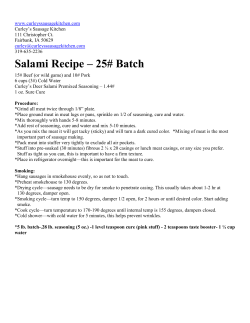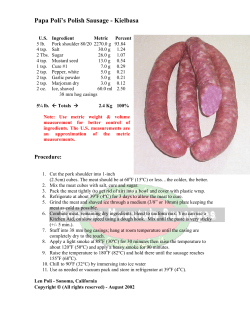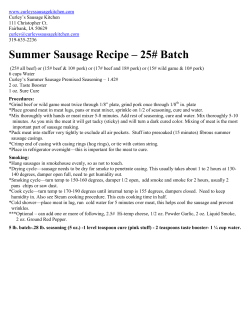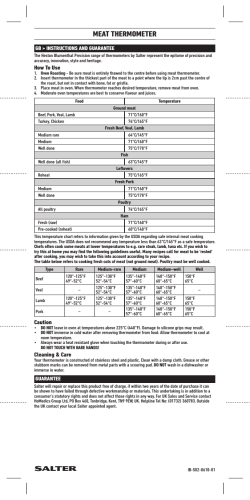
Isolation and Identification of some pathogenic Bacterial Species
Euphrates Journal of Agriculture Science-6 (4): 30-37 , (2014) Jar allah et al Isolation and Identification of some pathogenic Bacterial Species Contaminated from Meats in Butchers Shops and Kebab Restaurants in AL-Kut city Eman M. Jarallah Seaab Imad Sahib & Khalid Yassen Collage of science \ Babylon University Technical Institute / Kut Abstract: This study was conductedfor detectionof pathogenicbacterial species that contaminate meat in the butchers shops and kebab restaurants inAl-Kut city. Ten samples from 10 butcher shops and 10 restaurantswere collected.These samples were suspended in sterile normal saline in order to using for isolation and identification of pathogenic bacteria. The cultural properties and biochemical tests results revealed the bacterial isolates return to two+ bacterial species: Escherichia coli (40%) and Staphylococcus aureus (29%) in butchers shops, in front of E.coli (19%) ,S.aureus (28%) and Klebsiella sp. (9%) in restaurants . The antibiotics susceptibility pattern results showed all of these isolates were resist to most traditional antibiotics but in different ratios. عسل وتشخيص تعض اصناف الثكتريا الورضية هناللحوم في هحالت القصاتة وهطاعن الكثاب في هذينة الكوت خالذ ياسيي زغيرالساهلي صعاب عواد صاحة ايواى هحوذ جار هللا : الخالصة اجزيث ٌذي الذراسة للكشف عه اصىاف الثكحزيا المزضية الملُثً للحم في محالت القصاتة َمطاعم الكثاب في َضعث ٌذي العيىات في المحلُل الملحي. مطاعم03َ محالت قصاتة03 عيىات مه03 جمعث.مذيىة الكُت َقذ اظٍزت الىحائج الحي جم الحصُل.الفسلجي المعقم لغزض اسحخذامٍا في العزل َجشخيص الثكحزيا المزضية :عليٍا مه خصائص الُسط الزرعي َاالخحثارات الكيمُحيُية تان الثكحيزيا المعزَلة جعُد الى صىفيه ٌَما ) في محالت القصاتة اما في مطاعم%92( ) َالمكُرات العىقُدية الذٌثية تىسثة%03( االشزيشياالقُلُوي تىسثة ) َالكلثسيلة%92( ) َالمكُرات العىقُدية الذٌثية تىسثة%02( الكثاب فقذ ظٍزت االشزيشيا القُلُوية تىسثة اما وحائج فحص الحساسية للمضادات الحيُية فقذ اظٍزت ان جميع الثكحزيا المعزَلٍٍي مقاَمة.)% 2( تىسثة .الغلة المضادات الحيُية َلكه تىسة مخحلفة important are water availability, pH, and temperature (ICMSF, 1996). Food-borne diseases are an important cause of morbidity and mortality worldwide. It is estimated that foodborne diseases cause approximately 76 million illnesses, 325,000 hospitalizations, and 5,000 deaths in the United States each year(Mead et al.,1999).People's Introduction: Food is a chemically complex matrix, and predicting whether, or how fast, microorganisms will grow in any given food is difficult. Most foods contain sufficient nutrients to support microbial growth. Several factors encourage, prevent, or limit the growth of microorganisms in foods; the most 03 ISSN 2072-3875 Euphrates Journal of Agriculture Science-6 (4): 30-37 , (2014) increased traveling and free movement of foodstuffs has increased the risk of contracting food poisonings (Shahramet al., 2012). Contaminated raw or undercooked red meats are particularly important in transmitting these food borne pathogens(Mengand Doyle ,1998).Escherichia coliare considered the most commensally living microorganism in the alimentary tract of nearly all domestic and wild animals as well as human.EnteropathogenicE. coli organisms usually lead to severe diarrhea in infants and it may also be the causal organisms in appendicular abscess, peritonitis and cholecystitis( Mackieand McCartney,1989). The Enterobacteriaceae group of bacteria is the most challenging bacterial contaminant to raw and processed meat products worldwide. E. coli, Klebsiellaspecies are the most predominant speciesin all food poisoning cases associated with some meat products, Due to the rising incidence of food borne infections, there is an urgent need for control and/or prophylaxis for food poisoning outbreaks associated with meat products,it depends greatly on investigating the causative agents in food (meat products), eliminating them to ensure food safety and to protect public health from microbial contamination of food(AlMutairi,2011). Staphylococcal food poisoning is overwhelmingly the most prevalent of food borne infections in the United States (Ash,1997). This study carried out to investigate the diseases that caused by food contamination by the studied pathogens and determination the most bacteria that contaminate the fast food. Materials and Methods: Collection of samples: Ten fast food restaurant and ten meat butcher shopsin Kut citywerechosen randomly to be used in the present study. A total of 10 samples of fresh meat and 10 Kebab samples were obtainedaseptically and transferred to the laboratory in sterile plastic bagskept in Ice-Box, according to (Cheesbrough,1984). In the laboratory, one gram of each sample was weighted out and homogenized into 9 ml of sterile distilled water. From the ten –fold dilutions of the homogenates:0.1ml 0f 10-2 ,10-3and 10-4dilutions were plated in culture on theNutrient broth media, Nutrient Agar, Blood Agar andMacconky's Agar by pour method ,The plates were then incubated at 37˚C for 24-48 hours .After the end of incubation period , colonies were counted using colony counter .The count were expressed as colony forming units(CFU). Pure isolates of bacterial species were then stored at 4◦C for using in identification examination. Identification of bacterial species: The growing colonies transferred to new specialized media for each bacteria to obtain for a pure culture. Again the isolated bacteria were cultured at a 37˚C for 24h andstaining procedure were applied by using Gram stain. The biochemical tests were conducted by API 20 Kit to identify the isolated bacterial species. Antibiotics susceptibilitytest: Kirby-Bauer disk diffusion method was used to determine the antibioticresistant characteristics of the isolated organisms (Bauer et al.,1996).Mueller00 ISSN 2072-3875 Jar allah et al Euphrates Journal of Agriculture Science-6 (4): 30-37 , (2014) samples from butcher shops werecontaminated with two strains of bacteria (Table.1). Figures 1 and 2 represent the frequency of the pathogenic bacteria in studied Kebab and meat samples, respectively.As shown in these figures the positive species S.aureus was the more frequent pathogen in Kebab samples followed by E.coli and finally Klebsiella sp. While in meat samples E.coli came at the first then S.aureus . The antibiotics susceptibility patterns of these bacterial isolates towards some traditional antibiotics were examined due to diameters of inhibition zones(Tables 2 and 3). Jar allah et al Hinton agar plates were prepared and poured in Petri dishes after sterilization by autoclaving at 121C for 15 min .Then it used for testing the isolated microorganism for antibiotic susceptibility . The diameter of inhibition zones (mm) were recorded for all of the plates and then compared with the standard(National Committee;199). Results:The results of the present study showed that thestudied foods of restaurants were contaminated with three strains ofpathogenic bacteria, while thepostive samples of meat Table 1:Detection of bacterial isolates from meat sample and kebabsample. Bacterial isolate Staphylococcus aureus E.coli Klebsiellaspp Gram stain + - Meat samples 40% 29% - Kebab samples 28% 19% 9% 30 25 20 15 10 5 0 S. aureus E. Coli Klebsiella Spp. Figure 1: The percent of pathogenic bacteria isolates fromKebab samplesfrom fast food restaurant. 09 ISSN 2072-3875 Euphrates Journal of Agriculture Science-6 (4): 30-37 , (2014) Jar allah et al 45 40 35 30 25 20 15 10 5 0 E. Coli S. aureus Figure 2:The percent of pathogenic bacteria isolates from meat samples from butcher shops. Table 2:Mean of inhibition zone diameters (mm) of bacterial isolates of Kebab samples. Antibiotic Lincomycin Erythromycin Tetracyclin Gentamycin Amoxicillin Cefixime S.aureus 3±0.02 5±0.02 13±0.01 5±0.02 E.coli Klebsiella sp. 6±0.01 5±0.02 12±0.03 - 12±0.1 7±0.02 8±0.04 12±0.03 5±0.01 6±0.02 Table 3: Means of inhibition zone diameters (mm) of bacterial isolates of meat samples. Antibiotics Lincomycin Erythromycin Tetracyclin Gentamycin Amoxicillin Cefixime (-)mean resistance S.aureus E.coli 6±0.01 12±0.02 4±0.02 00 ISSN 2072-3875 10±0.03 6±0.02 7±0.02 13±0.02 6±0.04 5±0.03 Euphrates Journal of Agriculture Science-6 (4): 30-37 , (2014) isolates may have been the result of human contamination, a uniform pattern of human-associated strains was not observed. This result is agreement with other reports that S.aureus frequently are present in low numbers on raw meat surfaceoccurs infrequently (Saadiaand Hassanein ,2010). Biofilm forming bacteria is usually resistant to a wide range of antibiotics to find the prevalence of drug resistance bacteria; assays for susceptibility profiles and biofilm formation were performed. Resistance of bacterial isolates to available antibiotics and the biofilm formation ability of these isolates was commonly observed. The problem may be attributed to a number of possible sources, including the natural resistance of species to certain antibiotics possible transfer of antibiotic resistance among species. The present study demonstrated that Fast foods samples from restaurants in Kut City, were heavily contaminated with S.aureus ( 28% ). This represent a high level of contamination indicates a potential breakdown of hygiene at various stages of the food processing,S.aureus is most likely transmitted by hand of food workers.. Others also reported the Staphylococcus aureus as a source of food contamination (Kalantariet al.,2012). E.coli was the second most frequent food borne pathogen which was isolated from Fast foods samples ( 19%) ,Food or water or with the individuals handling the infant's child and unwashed vegetables or undercooked meat, by infected food workers via fecal-oral route. This result is agreement with other reports, It was suggested that it could increase the Discussion: Meat and meat products are considered as an excellent source of high quality animal protein, vitamins especially B complex, and certain minerals, especially iron .The source of infection is not determined in the majority of food born disease outbreaks. Currently the most important pathogens associated with meat products are Escherichia coli(Borch et al.,1996). The present study demonstrated that meat samples from butchers shops in Kut City, were heavily contaminated with E.coli ( 40% ), High contamination level of Coliforms in examined meat products may indicates unsanitary conditions of raw meat production from which produced. They are indicators of fecal pollution at slaughterhouse which begin from skinning and direct contact with knives and workers hands. Also, during evisceration and washing, contamination may come from intestinal contents as well as from water during rinsing and washing of carcasses. Undercooked meat products have caused many food poisoning incidents associated with E. coli which is present in the faeces, intestines and hide of healthy cattle from where it can potentially contaminate meat during the slaughtering process .This result was remarkably different from those previously reported by( ElGohary,1993)(78%) and (Vazgeceret al.,2004) (31%). In the current study, we evaluated the prevalence of S. aureus in meat; the distinct S. aureus populations on each product type suggest that meat animals are the predominant source of contamination. While a portion of the S. aureus 00 ISSN 2072-3875 Jar allah et al Euphrates Journal of Agriculture Science-6 (4): 30-37 , (2014) incidence of enteric pathogens(Angelilloet al.,2000). The bacterial isolateKlebsiella spp. was the third most frequent food borne pathogen which was isolated from Fast foods samples ( 9%), This is due to the rapid proliferation of such pathogen in meat product regardless their count is high or low.Klebsiellaspp was isolated in different rates of incidence. As well as have shown higher incidence ofKlebsiellasppin meat product (Ammar,2005). The microbial resistance of S.aureus isolated from fast food samples showed a high resistance rate to commonly used [Lincomycin , Erythromycin and amoxicillin ] which is clinically important and mayindicate inappropriate use of antimicrobials in Iraq,while , E. coli isolates showed low resistance to amoxicillin which is in agreement with the results of other investigators in other parts of the world (Cook et al.,2009). Klebsiellaspp was relatively resistant to commonly used antimicrobials .Our data are in agreement with several studies in other parts of the world showing an increasing portion of resistant isolates of Klebsiella spp.The prevalence of antimicrobial resistance among foodborne pathogens has increased during recent decades.This increase is attributed to the selection pressure created by using antimicrobials in food-producing animals, inaddition to the unregulated use of antibiotics by humans in developing countries(Allisonand Gilbert,1995). Recommendations:- 1- The use of modern techniques for the diagnosis isolated bacteria such as ELISA and PCR. 2-Study of pathological and histological effects of isolated bacteria in laboratory animals. REFERENCES: Allison, D.G. and Gilbert, P. (1995). Modification by surface association of antimicrobial susceptibility of bacterial populations. J. Ind. Microbiol. Biotechnol., 15: 311-317. Al-Mutairi,M.F. (2011). The Incidence of Enterobacteriaceae Causing Food Poisoning in Some Meat Products' Advance Journal of Food Science and Technology, 3(2): 116-121. Ammar, M.A.M. (2005). Spoilage and pathogenic microorganisms in traditional meat products in Assuit. M.Sc. Thesis, (Meat Hygiene), Faculty of Veterinary Medicine, Assiut University, Egypt. Angelillo, I.F.; Viggiani, N.M.; Rizzo L. and Bianco, A. (2000). Food handlers and food borne disease: knowledge, attitude sand reported behavior in Italy. J. Food Prot., 63: 381-385. Ash, M. (1997). Staphylococcus aureusand Staphylococcal Enterotoxins. In: Foodborne microorganisms of public health importance, 5th Edition, (Eds) Hocking, A.D., Arnold, G., Jenson, I., Newton, K. and Sutherland, P. pp 313-332. Conclusions: The highest rate of isolation ofS.aureus in kebab samples while thehighest rate of isolation E.coliin meat samples. 03 ISSN 2072-3875 Jar allah et al Euphrates Journal of Agriculture Science-6 (4): 30-37 , (2014) food pathogens. Clays L.td, St. Ives. Plc., Bungay Suffolk, UK. Kalantari, S.; Sepehri, G.; Bahrampour A. and Sepehri, E. (2012). Determination of bacterial contamination isolated from Sandwiches in Kerman City and their resistance to commonly used antimicrobials. Archives of Applied Science Research, 4 (2):1100-1105. Mackie, K.J. and McCartney, J.G. (1989). Medical Microbiology. Vol. 1 and 2, 30th Edn., Churchill Living Stone, Edinburg London Melbourne and New York. Mead, S.; Slutsker, L.; Dietz, V.; McCaig, L. F.; Bresee, J. S.; Shapiro, C.; Griffin, P P. M. and Tauxe, R. V. (1999).Food-related illness and death in the United States.Emerg. Infect. Dis.,5: 607625. Meng, J. and Doyle, M.P. (1998). Emerging and evolving microbial foodborne pathogens. Bull Inst. Pasteur, 96: 151-164. National Committee for Clinical Laboratory Standards. Performance standards for antimicrobial disk susceptibility tests. Approved standard M2-A6. Wayne, Pa: National Committee for Clinical Laboratory Standards; 1997. Saadia, M. and Hassanein, E. (2010). The Microbial Quality of Fast Food and Traditional Fast Food. Nature and Science, (10):8. Shahram, K.; Gholamreza, S.; Abbas B. and Ehsan S. (2012). Bauer, A.W.; Kirby, M.M.; Sheris, J.S. and Turek, M. (1996). Antibiotic sensitivity testing by single disc method. Am. J. Clin. Pathol. (45): 939-396. Borch, E.; Nesbakken, T. and Christenes, H. (1996).Hazard identification in swine slaughter with respect to foodborne bacteria. Int. J. Food Microbiol., 30: 9-25. Cheesbrough, M. (1984): Microbiological examination of specimens and biochemical testing of microorganisms in: Medical laboratory manual of tropical countries. 1st ed. Vol. 2. Tropical Health Technology, Butterworth Heinemann Ltd. Printed in Great Britain At University Press, Cambridge pp. 26-39, 57-69s. Cook, A.; Reid-Smith, R.; Irwin, R.; McEwen, S.A.; Valdivieso-Garcia A. and Ribble C. (2009).Antimicrobial resistance in Campylobacter, Salmonella, and Escherichia coli isolated from retail turkey meat from southern Ontario, Canada.J. Food Prot., 72, 473-481. El-Gohary, A.H. (1993). Sausage and minced meat as a source of food poisoning microorganisms to man. Assiut, Vet. Med. J., 30(59). ICMSF, (1996). International commission on microbiological specifications for foods. Microorganisms in foods. 5 microbiological specifications of 03 ISSN 2072-3875 Jar allah et al Euphrates Journal of Agriculture Science-6 (4): 30-37 , (2014) Jar allah et al Determination of bacterial contamination isolated from Sandwiches in Kerman City and their resistance to commonly used antimicrobials. Archives of Applied Science Research, 4 (2):1100-1105. Vazgecer, B.; Ula B. and Oztan, A. (2004). Microbiological and chemical qualities of chicken doner kebab retailed on the Turkish restaurants. Food Control, 15(4): 261-264. 03 ISSN 2072-3875
© Copyright 2026









